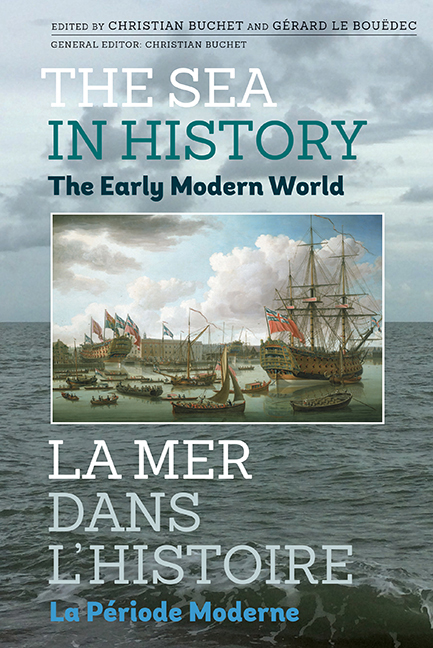Book contents
- Frontmatter
- Contents
- List of Illustrations
- List of Contributors
- Introduction générale et remerciements par
- General introduction and acknowledgements
- Introduction (français)
- Introduction (English)
- LA RÉUSSITE PAR LA MER:La reussite par la mer des territoires et des communautés littorales
- La construction d'un espace mondial: La circulation maritime et les ports
- La forte croissance de l'économie des pêches et des échanges
- Les acteurs de la dynamique maritime
- LA PUISSANCE MARITIME INSTRUMENT DE LA PUISSANCE POLITIQUE ET D'UNE STRATÉGIE GLOBALE DE RAYONNEMENT VOIRE DE DOMINATION: Les puissances maritimes occidentales
- L'océan Indien, entre convoitises et indifférences
- Les puissances maritimes asiatiques
- L'Afrique
- La politique maritime et l'idéologie
- Mer et développement technologique
- An engine, not a needle: ocean navigation as a motor of innovation in Europe
- The sea as a knowledge development factor in the medical field
- Développement maritime et maîtrise économique et financière
- Développement maritime et maîtrise organisationnelle
- Conclusion (français)
- Conclusion (English)
- Conclusion générale par
- General conclusion by
- Miscellaneous Endmatter
- Miscellaneous Endmatter
An engine, not a needle: ocean navigation as a motor of innovation in Europe
from Mer et développement technologique
Published online by Cambridge University Press: 11 May 2017
- Frontmatter
- Contents
- List of Illustrations
- List of Contributors
- Introduction générale et remerciements par
- General introduction and acknowledgements
- Introduction (français)
- Introduction (English)
- LA RÉUSSITE PAR LA MER:La reussite par la mer des territoires et des communautés littorales
- La construction d'un espace mondial: La circulation maritime et les ports
- La forte croissance de l'économie des pêches et des échanges
- Les acteurs de la dynamique maritime
- LA PUISSANCE MARITIME INSTRUMENT DE LA PUISSANCE POLITIQUE ET D'UNE STRATÉGIE GLOBALE DE RAYONNEMENT VOIRE DE DOMINATION: Les puissances maritimes occidentales
- L'océan Indien, entre convoitises et indifférences
- Les puissances maritimes asiatiques
- L'Afrique
- La politique maritime et l'idéologie
- Mer et développement technologique
- An engine, not a needle: ocean navigation as a motor of innovation in Europe
- The sea as a knowledge development factor in the medical field
- Développement maritime et maîtrise économique et financière
- Développement maritime et maîtrise organisationnelle
- Conclusion (français)
- Conclusion (English)
- Conclusion générale par
- General conclusion by
- Miscellaneous Endmatter
- Miscellaneous Endmatter
Summary
ABSTRACT. This article shows how the development of navigation is not just a simple push, but the driver of innovation in Europe. Innovation stimulated by maritime needs and financed to a great degree by maritime activities, of which the effects were crucial for the scientific, industrial, and even political revolutions by the advent of another vision of that domain.
RÉSUMÉ. Cette contribution montre combien le développement de la navigation n'a pas été un simple aiguillon, mais le moteur de l'innovation en Europe. Une innovation stimulée par les besoins du maritime et financée, dans une large mesure, par lui, dont les effets étaient déterminants sur la révolution scientifique, la révolution industrielle, voire même politique par l'avènement d'une autre vision de l'espace.
Long-range ocean navigation went hand-in-hand with European innovation from the time of the Roman Empire. Innovations in cartography and astronomical observations aided the Roman expansion of trade routes in Asia and Africa. For example, geographer Claudius Ptolemy created an atlas called the Geography, for the first time using lines of latitude and longitude to specifically locate Roman navigation routes and trading entrepôts as far east as China.
When the Roman Empire ended in 476 CE, so too did European advancement in geography and navigation. The European interest in long-distance navigation was only reawakened in the 1400s with the slow choking of the overland Silk Routes that had for centuries connected Europe to the riches of Asia. With travel becoming perilous due to the disintegration of the Mongolian Empire and the order it had imposed along the trade routes, merchants now needed a way to reach Asia by sea. Explorers flying the Portuguese flag laboriously clawed their way south and east around Africa to reach the Indian Ocean. Christopher Columbus, sailing under the Spanish flag (and under a delusion about the true size of the Earth—it was much bigger than he guessed), took the novel approach of sailing west to reach Asia. He landed in the Americas instead. Other nations quickly followed suite. By 1500, the contest to create empires and dominate oceanic trade routes had begun.
As these long-range ocean voyages began to take form, the tools required for accurate navigation also evolved.
- Type
- Chapter
- Information
- The Sea in History - The Early Modern World , pp. 721 - 731Publisher: Boydell & BrewerPrint publication year: 2017



